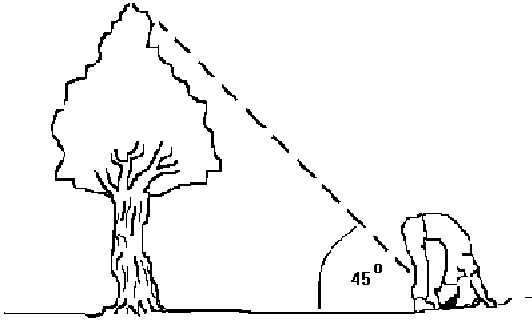Copyright © University of Cambridge. All rights reserved.
'Timber!' printed from https://nrich.maths.org/
Show menu
Why do this problem?
This problem offers an intriguing context which learners can explore for themselves practically. As they consider why each method works, they will be drawing on their knowledge of fractions and ratio, and angles in a triangle.
Possible approach
This problem featured in the NRICH Primary webinar in April 2022.
You may choose to introduce this task outside, using a tree in your own school environment as the context rather than the fictional context in the problem as written.
Whatever context you choose, once you have posed the challenge of needing to find out the height of the tree, give learners time to talk in pairs about what they could do. You may find that some children suggest Mo's and/or Sam's method themselves, in which case you won't need to introduce the characters of Mo/Sam.
The main point of this task is to give pupils the opportunity to consider why these two methods work, so give pairs plenty of time to think together. Encourage them to use whatever resources they wish to help them in their task. As they talk, wander round the room and listen out for those who are making progress. Bringing everyone together for a mini plenary will give the class chance to hear about others' ideas. This benefits those who feel stuck, but also helps those who have made progress to clarify their ideas as they explain their thinking to others.
If appropriate, you could reveal the picture that accompanies Sam's method on screen. You could warn the class when you're about to show it, so that individuals can choose whether or not to look. Can learners use this picture to sketch a triangle that might help them think about Sam's method? You may wish to print out copies of this sheet for learners, which gives Sam's method and the picture.
In the final plenary, invite a few pairs of children to outline their reasoning for each method. Encourage the rest of the class to ask questions for clarification and facilitate a discussion so that a consensus is reached.
A lovely way to follow up this task would be to try both methods out in your own school grounds, if possible. Do the two methods give similar answers?
Key questions
Have you tried drawing a picture or diagram of each method?
In Mo's method, what is the relationship between the length of the cane and the length of its shadow? How could that help you work out the height of the tree if you know the length of the tree's shadow?
How might the picture of Sam's method included in the problem help?
Possible extension
You could invite learners to find out about other ways of estimating the height of a tree. The two methods outlined in this task have been chosen deliberately as they can be explained using mathematics usually encountered by upper primary learners. Some of the new ways they find out about might use knowledge and skills that they have not met yet, but that does not necessarily matter. It can be motivating to know that in a few years' time, they will be equipped with the understanding needed to explain why another method works.
Possible support
Drawing a diagram or picture is a good way to get started on this task. Some learners might find it helpful to work with real numbers in order to unpick Mo's method. In this case, the following examples might help:
Length of tree's shadow: 36.3m
Length of cane's shadow: 1.23m
